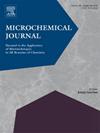利用近红外光谱从椰奶中辨别地理区域的模型:结合经典化学计量学、机器学习和深度学习进行探索
IF 4.9
2区 化学
Q1 CHEMISTRY, ANALYTICAL
引用次数: 0
摘要
这项工作建议通过近红外(NIR)光谱(傅立叶变换近红外光谱和显微近红外光谱),结合从传统到现代的化学计量分类法,探索椰奶地理来源地区的鉴别模型。判别模型是利用从经典(主成分分析-PCA、偏最小二乘判别分析-PLS-DA、线性判别分析-LDA)到现代的定性化学计量学技术开发的,包括机器学习(支持向量机-SVM、k-最近邻-KNN、人工神经网络-ANN)和深度学习(简单卷积神经网络-S-CNN、S-AlexNET、残差网络-ResNET)的分类器。我们使用了三个原产于泰国的椰奶产地,包括南部地区(春蓬府)、中部地区(宋甘府)和东部地区(春武里府)。我们的研究结果表明,利用傅立叶变换近红外光谱,SVM 和 ResNET 分类器在区分椰奶的地理来源区域方面能产生最佳性能。此外,在使用 Micro-NIR 时,LDA、SVM、KNN 和 ResNET 分类器的准确率最高。根据卡帕系数进行分类时,上述性能鉴别模型都非常出色。本研究的结论是,在经典到现代化学计量分类器的支持下,傅立叶变换近红外光谱和微近红外光谱均可用于评估椰奶的地理区域来源。此外,本研究的方法还包括一种发现重要近红外光谱特征的策略,以达到可解释性的目的,从而促进所有类型分类器对结果的定性解释。本文章由计算机程序翻译,如有差异,请以英文原文为准。
Discrimination model of geographical area from coconut milk by near-infrared spectroscopy: Exploration in tandem with classical chemometrics, machine learning, and deep learning
This work proposes exploring the discrimination model by near-infrared (NIR) spectroscopy (FT-NIR and Micro-NIR) for geographical source areas of coconut milk in tandem with the classical to modern chemometrics classifier. The discrimination model was developed using qualitative chemometrics techniques from classic (Principal Component Analysis-PCA, Partial Least Squares Discriminant Analysis-PLS-DA, Linear Discriminant Analysis-LDA) to modern, including classifiers from machine learning (Support Vector Machine-SVM, k-Nearest Neighbor-KNN, Artificial Neural Network-ANN) and deep learning (Simple Convolutional Neural Networks-S-CNN, S-AlexNET, Residual Networks-ResNET). Three sources as geographical areas of coconut milk originally from Thailand were used, including the south region (Chumphon Province), middle region (Samut Songkhram Province), and east region (Chonburi Province). Our findings showed that a classifier from SVM and ResNET could yield the optimal performance for discriminating the geographical source area of coconut milk using FT-NIR. Furthermore, when using Micro-NIR, the classifier from LDA, SVM, KNN and ResNET delivered the highest accuracy. The performance discrimination models above were excellent when classified based on the kappa coefficient. This study concluded that both FT-NIR and Micro-NIR supported by classical to modern chemometric classifiers could be used to evaluate the geographical area source from coconut milk. Also, the method in this study includes a strategy for discovering feature-important NIR spectra for interpretability purposes, thereby facilitating the qualitative interpretation of results for all types of classifiers.
求助全文
通过发布文献求助,成功后即可免费获取论文全文。
去求助
来源期刊

Microchemical Journal
化学-分析化学
CiteScore
8.70
自引率
8.30%
发文量
1131
审稿时长
1.9 months
期刊介绍:
The Microchemical Journal is a peer reviewed journal devoted to all aspects and phases of analytical chemistry and chemical analysis. The Microchemical Journal publishes articles which are at the forefront of modern analytical chemistry and cover innovations in the techniques to the finest possible limits. This includes fundamental aspects, instrumentation, new developments, innovative and novel methods and applications including environmental and clinical field.
Traditional classical analytical methods such as spectrophotometry and titrimetry as well as established instrumentation methods such as flame and graphite furnace atomic absorption spectrometry, gas chromatography, and modified glassy or carbon electrode electrochemical methods will be considered, provided they show significant improvements and novelty compared to the established methods.
 求助内容:
求助内容: 应助结果提醒方式:
应助结果提醒方式:


